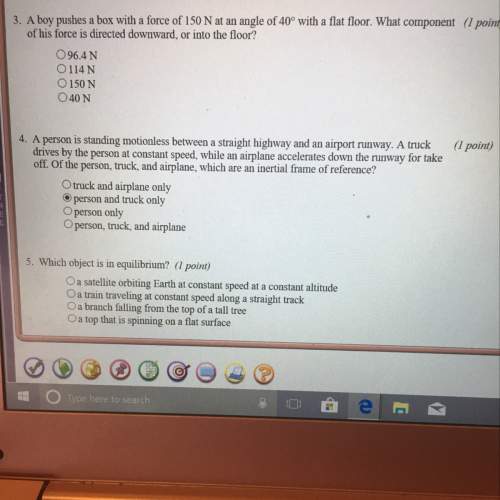
Step 1 of 2
Each person in your group obtains a ruler and at least one ticker tape segment from the staff. All the tape segments were generated using the same ticker timer. Do not write on or fold the tapes. If a ticker timer is available, examine it so that you are familiar with how it works.
Step 2 of 2
The common way of analyzing the motion of the objects is to perform a ticker tape analysis. The trial of dots provides a history of the object’s motion. The distance between dots on a ticker tape represents the object’s position change during that time interval. A large distance between dots indicates that the object was moving fast during that time interval. A small distance between dots means the object was moving slowly during that time interval.
Velocity is the change in displacement. The dots are equally spaced. Therefore, the motion represented by the segment of tape is moving with constant speed.

Answers: 1


Other questions on the subject: Physics

Physics, 22.06.2019 01:40, sasalinas2001
In all trials, the magnitude of the final velocity for g1 + g2 was less than the magnitude of any initial velocity. as mass increased, what happened to the velocity? the velocity decreased. the velocity increased. the velocity of g1 + g2 could not be measured. the velocity was not affected by the mass increase.
Answers: 1

Physics, 22.06.2019 02:00, llamasking
Chapter 23, problem 075 the figure shows a geiger counter, a device used to detect ionizing radiation (radiation that causes ionization of atoms). the counter consists of a thin, positively charged central wire surrounded by a concentric, circular, conducting cylindrical shell with an equal negative charge. thus, a strong radial electric field is set up inside the shell. the shell contains a low-pressure inert gas. a particle of radiation entering the device through the shell wall ionizes a few of the gas atoms. the resulting free electrons (e) are drawn to the positive wire. however, the electric field is so intense that, between collisions with gas atoms, the free electrons gain energy sufficient to ionize these atoms also. more free electrons are thereby created, and the process is repeated until the electrons reach the wire. the resulting "avalanche" of electrons is collected by the wire, generating a signal that is used to record the passage of the original particle of radiation. suppose the radius of the central wire is 24 âµm, the inner radius of the shell 2.3 cm, and the length of the shell 14 cm. if the electric field at the shell's inner wall is 2.8 ă— 104 n/c, what is the total positive charge on the central wire?
Answers: 1

Physics, 22.06.2019 14:40, hastephens03
According to valence bond theory, which orbitals overlap in the formation of the bond in hf according to valence bond theory, which orbitals overlap in the formation of the bond in hf 2s on h and 2p on f 1s on h and 2s on f 1s on h and 1p on f 1s on h and 2p on f 1s on h and 3p on f
Answers: 3

Physics, 22.06.2019 23:10, Jgarciar541
Atorque acting on an object tends to produce a. equilibrium b. rotation c. linear motion d. velocity e. a center of gravity
Answers: 2
You know the right answer?
Step 1 of 2
Each person in your group obtains a ruler and at least one ticker tape segment from the...
Questions in other subjects:

Chemistry, 28.01.2020 07:31

Health, 28.01.2020 07:31

Mathematics, 28.01.2020 07:31


English, 28.01.2020 07:31

Physics, 28.01.2020 07:31

English, 28.01.2020 07:31

Mathematics, 28.01.2020 07:31

Chemistry, 28.01.2020 07:31

Mathematics, 28.01.2020 07:31




